Financial Techniques for Managers: Tesco Case Study Analysis Report
VerifiedAdded on 2023/01/09
|28
|8353
|42
Report
AI Summary
This report provides a comprehensive analysis of financial techniques for managers, using Tesco as a case study. It begins by comparing financial and management accounting, exploring their systems and benefits. The report then delves into working capital management, ratio analysis, and their roles in assessing organizational performance. It covers investment appraisal techniques, evaluating various methods and recommending the most appropriate project. Furthermore, the report examines different costing methods, including absorption and marginal costing, and their application in pricing decisions, along with variance analysis. The report integrates financial and management accounting systems into organizational processes, evaluates financial statements, and highlights the benefits of management accounting in supporting financial decision-making. Finally, it concludes with the importance of financial accounting for managers to make future decisions.

Financial techniques
for managers
for managers
Paraphrase This Document
Need a fresh take? Get an instant paraphrase of this document with our AI Paraphraser
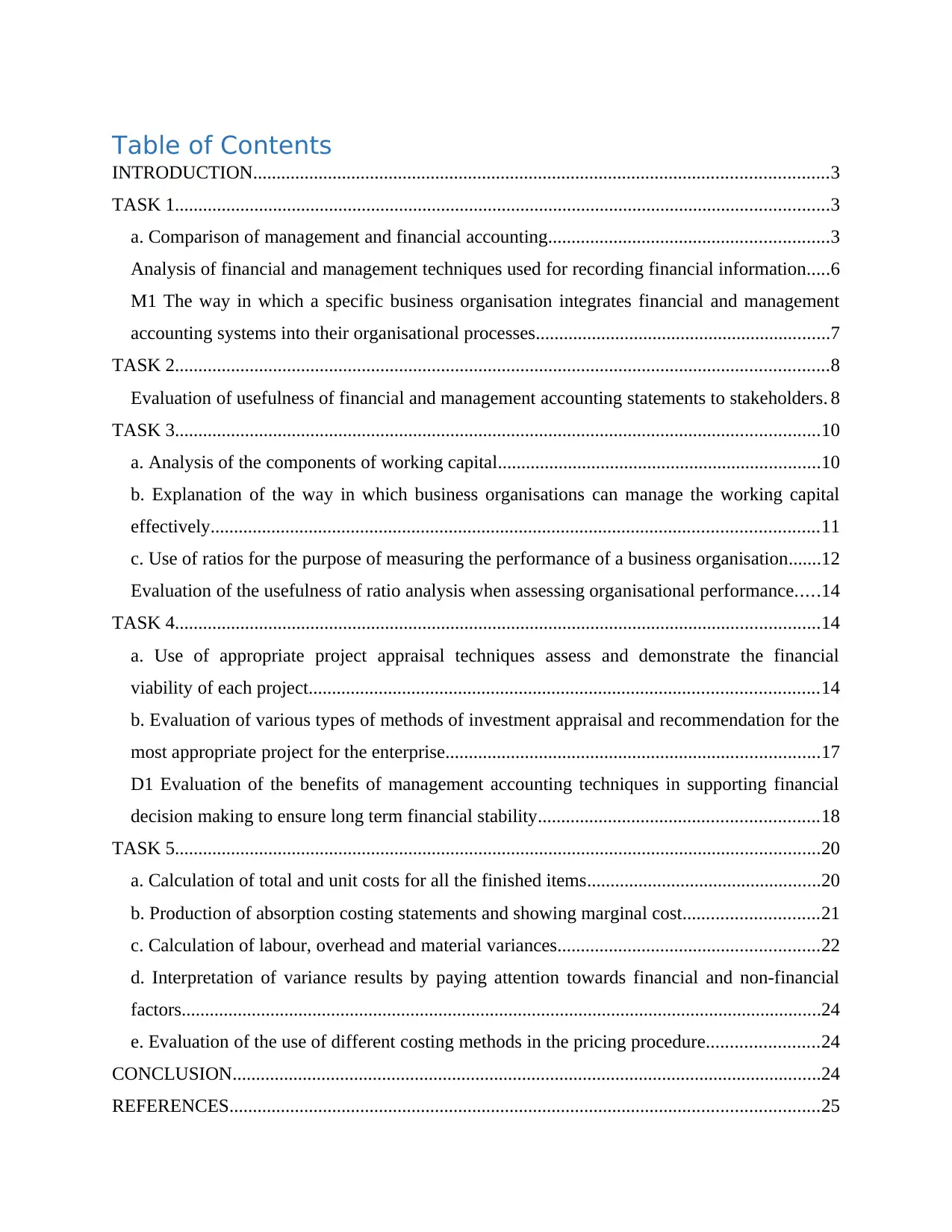
Table of Contents
INTRODUCTION...........................................................................................................................3
TASK 1............................................................................................................................................3
a. Comparison of management and financial accounting............................................................3
Analysis of financial and management techniques used for recording financial information.....6
M1 The way in which a specific business organisation integrates financial and management
accounting systems into their organisational processes...............................................................7
TASK 2............................................................................................................................................8
Evaluation of usefulness of financial and management accounting statements to stakeholders. 8
TASK 3..........................................................................................................................................10
a. Analysis of the components of working capital.....................................................................10
b. Explanation of the way in which business organisations can manage the working capital
effectively..................................................................................................................................11
c. Use of ratios for the purpose of measuring the performance of a business organisation.......12
Evaluation of the usefulness of ratio analysis when assessing organisational performance.....14
TASK 4..........................................................................................................................................14
a. Use of appropriate project appraisal techniques assess and demonstrate the financial
viability of each project.............................................................................................................14
b. Evaluation of various types of methods of investment appraisal and recommendation for the
most appropriate project for the enterprise................................................................................17
D1 Evaluation of the benefits of management accounting techniques in supporting financial
decision making to ensure long term financial stability............................................................18
TASK 5..........................................................................................................................................20
a. Calculation of total and unit costs for all the finished items..................................................20
b. Production of absorption costing statements and showing marginal cost.............................21
c. Calculation of labour, overhead and material variances........................................................22
d. Interpretation of variance results by paying attention towards financial and non-financial
factors.........................................................................................................................................24
e. Evaluation of the use of different costing methods in the pricing procedure........................24
CONCLUSION..............................................................................................................................24
REFERENCES..............................................................................................................................25
INTRODUCTION...........................................................................................................................3
TASK 1............................................................................................................................................3
a. Comparison of management and financial accounting............................................................3
Analysis of financial and management techniques used for recording financial information.....6
M1 The way in which a specific business organisation integrates financial and management
accounting systems into their organisational processes...............................................................7
TASK 2............................................................................................................................................8
Evaluation of usefulness of financial and management accounting statements to stakeholders. 8
TASK 3..........................................................................................................................................10
a. Analysis of the components of working capital.....................................................................10
b. Explanation of the way in which business organisations can manage the working capital
effectively..................................................................................................................................11
c. Use of ratios for the purpose of measuring the performance of a business organisation.......12
Evaluation of the usefulness of ratio analysis when assessing organisational performance.....14
TASK 4..........................................................................................................................................14
a. Use of appropriate project appraisal techniques assess and demonstrate the financial
viability of each project.............................................................................................................14
b. Evaluation of various types of methods of investment appraisal and recommendation for the
most appropriate project for the enterprise................................................................................17
D1 Evaluation of the benefits of management accounting techniques in supporting financial
decision making to ensure long term financial stability............................................................18
TASK 5..........................................................................................................................................20
a. Calculation of total and unit costs for all the finished items..................................................20
b. Production of absorption costing statements and showing marginal cost.............................21
c. Calculation of labour, overhead and material variances........................................................22
d. Interpretation of variance results by paying attention towards financial and non-financial
factors.........................................................................................................................................24
e. Evaluation of the use of different costing methods in the pricing procedure........................24
CONCLUSION..............................................................................................................................24
REFERENCES..............................................................................................................................25
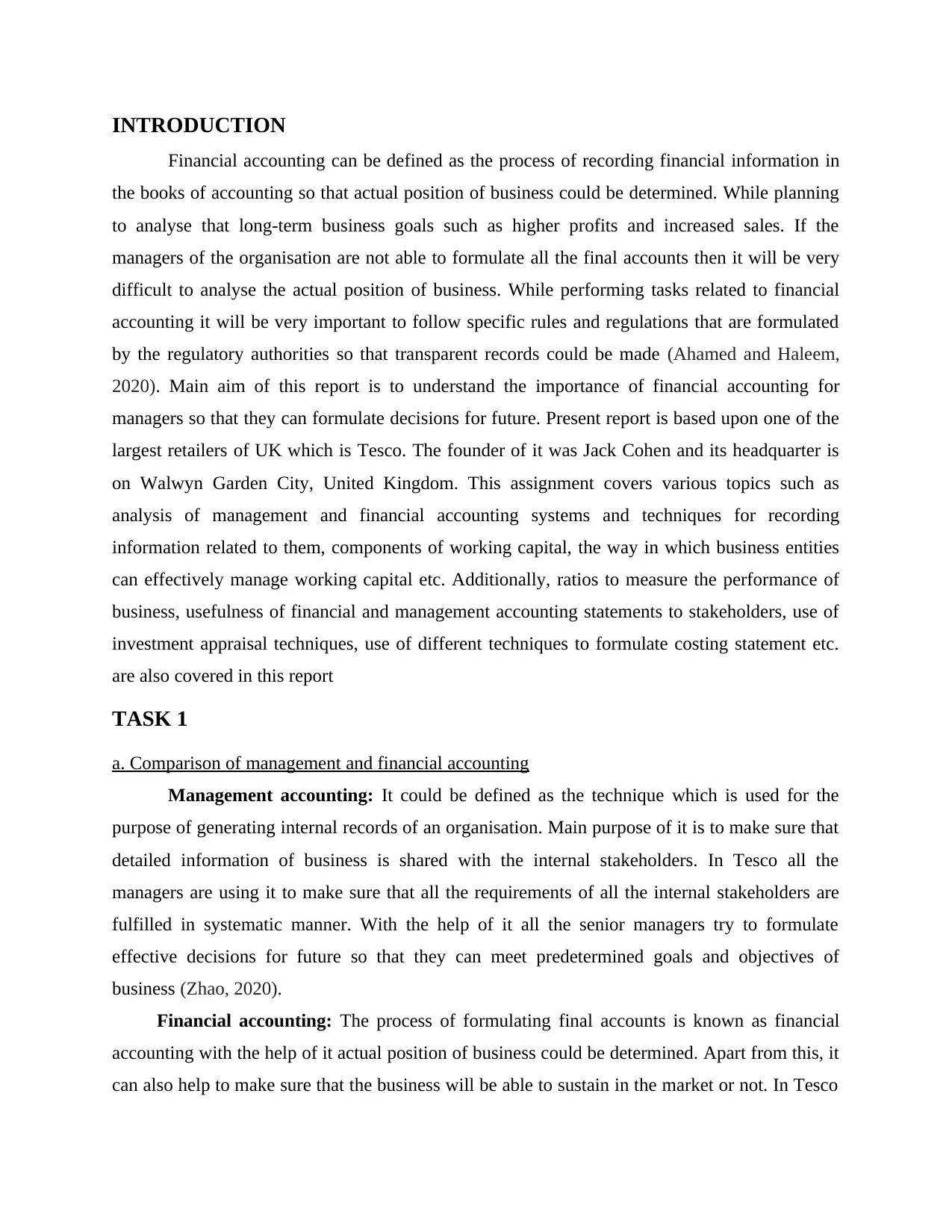
INTRODUCTION
Financial accounting can be defined as the process of recording financial information in
the books of accounting so that actual position of business could be determined. While planning
to analyse that long-term business goals such as higher profits and increased sales. If the
managers of the organisation are not able to formulate all the final accounts then it will be very
difficult to analyse the actual position of business. While performing tasks related to financial
accounting it will be very important to follow specific rules and regulations that are formulated
by the regulatory authorities so that transparent records could be made (Ahamed and Haleem,
2020). Main aim of this report is to understand the importance of financial accounting for
managers so that they can formulate decisions for future. Present report is based upon one of the
largest retailers of UK which is Tesco. The founder of it was Jack Cohen and its headquarter is
on Walwyn Garden City, United Kingdom. This assignment covers various topics such as
analysis of management and financial accounting systems and techniques for recording
information related to them, components of working capital, the way in which business entities
can effectively manage working capital etc. Additionally, ratios to measure the performance of
business, usefulness of financial and management accounting statements to stakeholders, use of
investment appraisal techniques, use of different techniques to formulate costing statement etc.
are also covered in this report
TASK 1
a. Comparison of management and financial accounting
Management accounting: It could be defined as the technique which is used for the
purpose of generating internal records of an organisation. Main purpose of it is to make sure that
detailed information of business is shared with the internal stakeholders. In Tesco all the
managers are using it to make sure that all the requirements of all the internal stakeholders are
fulfilled in systematic manner. With the help of it all the senior managers try to formulate
effective decisions for future so that they can meet predetermined goals and objectives of
business (Zhao, 2020).
Financial accounting: The process of formulating final accounts is known as financial
accounting with the help of it actual position of business could be determined. Apart from this, it
can also help to make sure that the business will be able to sustain in the market or not. In Tesco
Financial accounting can be defined as the process of recording financial information in
the books of accounting so that actual position of business could be determined. While planning
to analyse that long-term business goals such as higher profits and increased sales. If the
managers of the organisation are not able to formulate all the final accounts then it will be very
difficult to analyse the actual position of business. While performing tasks related to financial
accounting it will be very important to follow specific rules and regulations that are formulated
by the regulatory authorities so that transparent records could be made (Ahamed and Haleem,
2020). Main aim of this report is to understand the importance of financial accounting for
managers so that they can formulate decisions for future. Present report is based upon one of the
largest retailers of UK which is Tesco. The founder of it was Jack Cohen and its headquarter is
on Walwyn Garden City, United Kingdom. This assignment covers various topics such as
analysis of management and financial accounting systems and techniques for recording
information related to them, components of working capital, the way in which business entities
can effectively manage working capital etc. Additionally, ratios to measure the performance of
business, usefulness of financial and management accounting statements to stakeholders, use of
investment appraisal techniques, use of different techniques to formulate costing statement etc.
are also covered in this report
TASK 1
a. Comparison of management and financial accounting
Management accounting: It could be defined as the technique which is used for the
purpose of generating internal records of an organisation. Main purpose of it is to make sure that
detailed information of business is shared with the internal stakeholders. In Tesco all the
managers are using it to make sure that all the requirements of all the internal stakeholders are
fulfilled in systematic manner. With the help of it all the senior managers try to formulate
effective decisions for future so that they can meet predetermined goals and objectives of
business (Zhao, 2020).
Financial accounting: The process of formulating final accounts is known as financial
accounting with the help of it actual position of business could be determined. Apart from this, it
can also help to make sure that the business will be able to sustain in the market or not. In Tesco
⊘ This is a preview!⊘
Do you want full access?
Subscribe today to unlock all pages.

Trusted by 1+ million students worldwide
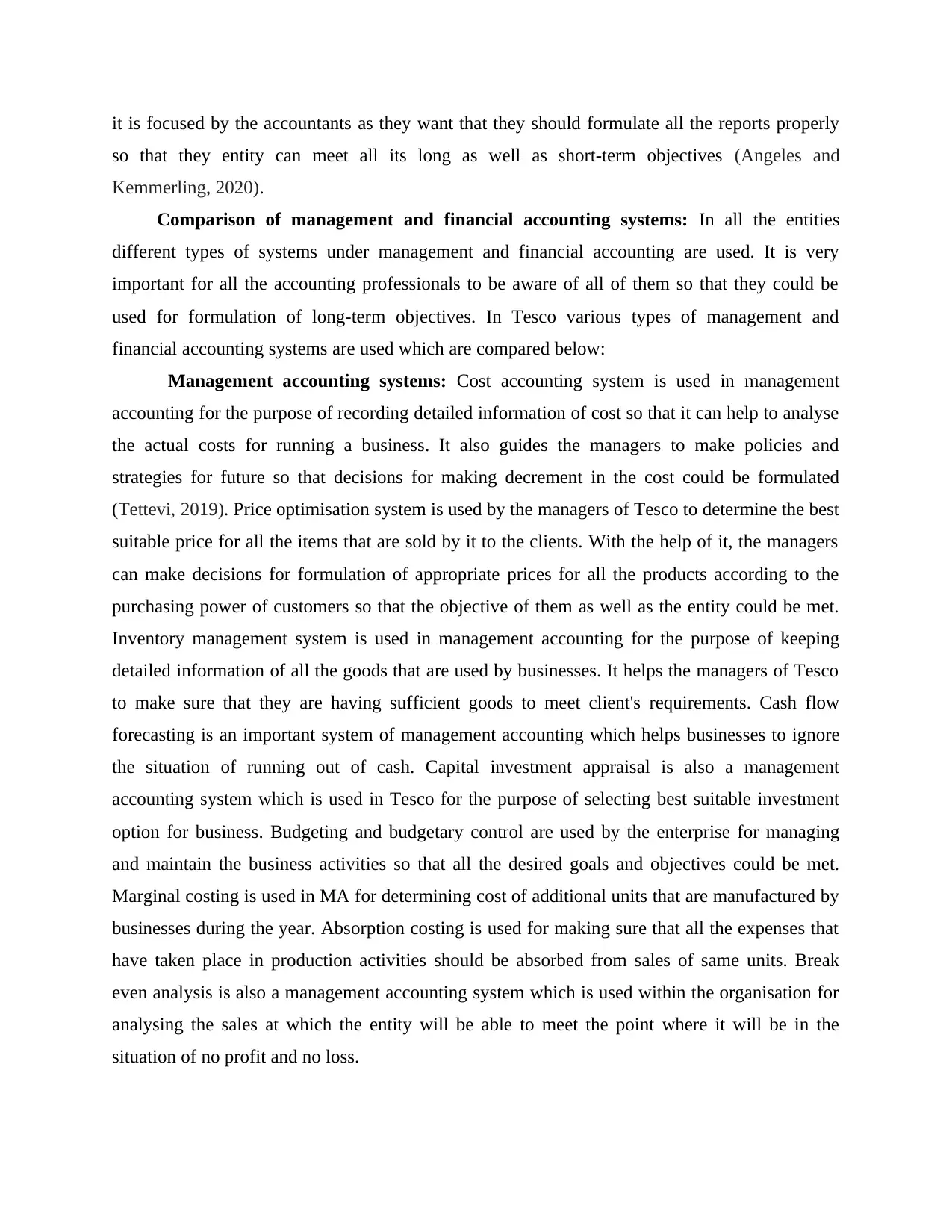
it is focused by the accountants as they want that they should formulate all the reports properly
so that they entity can meet all its long as well as short-term objectives (Angeles and
Kemmerling, 2020).
Comparison of management and financial accounting systems: In all the entities
different types of systems under management and financial accounting are used. It is very
important for all the accounting professionals to be aware of all of them so that they could be
used for formulation of long-term objectives. In Tesco various types of management and
financial accounting systems are used which are compared below:
Management accounting systems: Cost accounting system is used in management
accounting for the purpose of recording detailed information of cost so that it can help to analyse
the actual costs for running a business. It also guides the managers to make policies and
strategies for future so that decisions for making decrement in the cost could be formulated
(Tettevi, 2019). Price optimisation system is used by the managers of Tesco to determine the best
suitable price for all the items that are sold by it to the clients. With the help of it, the managers
can make decisions for formulation of appropriate prices for all the products according to the
purchasing power of customers so that the objective of them as well as the entity could be met.
Inventory management system is used in management accounting for the purpose of keeping
detailed information of all the goods that are used by businesses. It helps the managers of Tesco
to make sure that they are having sufficient goods to meet client's requirements. Cash flow
forecasting is an important system of management accounting which helps businesses to ignore
the situation of running out of cash. Capital investment appraisal is also a management
accounting system which is used in Tesco for the purpose of selecting best suitable investment
option for business. Budgeting and budgetary control are used by the enterprise for managing
and maintain the business activities so that all the desired goals and objectives could be met.
Marginal costing is used in MA for determining cost of additional units that are manufactured by
businesses during the year. Absorption costing is used for making sure that all the expenses that
have taken place in production activities should be absorbed from sales of same units. Break
even analysis is also a management accounting system which is used within the organisation for
analysing the sales at which the entity will be able to meet the point where it will be in the
situation of no profit and no loss.
so that they entity can meet all its long as well as short-term objectives (Angeles and
Kemmerling, 2020).
Comparison of management and financial accounting systems: In all the entities
different types of systems under management and financial accounting are used. It is very
important for all the accounting professionals to be aware of all of them so that they could be
used for formulation of long-term objectives. In Tesco various types of management and
financial accounting systems are used which are compared below:
Management accounting systems: Cost accounting system is used in management
accounting for the purpose of recording detailed information of cost so that it can help to analyse
the actual costs for running a business. It also guides the managers to make policies and
strategies for future so that decisions for making decrement in the cost could be formulated
(Tettevi, 2019). Price optimisation system is used by the managers of Tesco to determine the best
suitable price for all the items that are sold by it to the clients. With the help of it, the managers
can make decisions for formulation of appropriate prices for all the products according to the
purchasing power of customers so that the objective of them as well as the entity could be met.
Inventory management system is used in management accounting for the purpose of keeping
detailed information of all the goods that are used by businesses. It helps the managers of Tesco
to make sure that they are having sufficient goods to meet client's requirements. Cash flow
forecasting is an important system of management accounting which helps businesses to ignore
the situation of running out of cash. Capital investment appraisal is also a management
accounting system which is used in Tesco for the purpose of selecting best suitable investment
option for business. Budgeting and budgetary control are used by the enterprise for managing
and maintain the business activities so that all the desired goals and objectives could be met.
Marginal costing is used in MA for determining cost of additional units that are manufactured by
businesses during the year. Absorption costing is used for making sure that all the expenses that
have taken place in production activities should be absorbed from sales of same units. Break
even analysis is also a management accounting system which is used within the organisation for
analysing the sales at which the entity will be able to meet the point where it will be in the
situation of no profit and no loss.
Paraphrase This Document
Need a fresh take? Get an instant paraphrase of this document with our AI Paraphraser
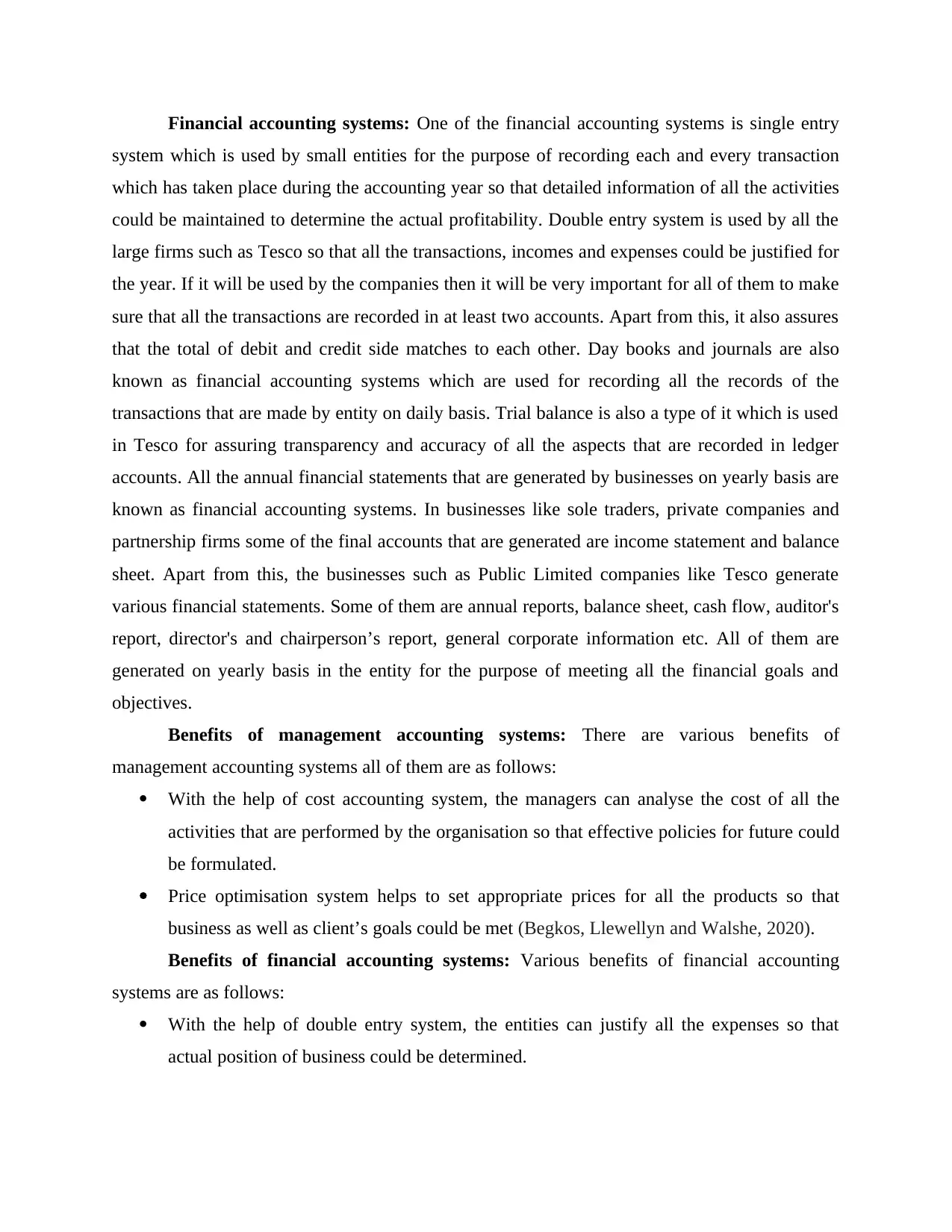
Financial accounting systems: One of the financial accounting systems is single entry
system which is used by small entities for the purpose of recording each and every transaction
which has taken place during the accounting year so that detailed information of all the activities
could be maintained to determine the actual profitability. Double entry system is used by all the
large firms such as Tesco so that all the transactions, incomes and expenses could be justified for
the year. If it will be used by the companies then it will be very important for all of them to make
sure that all the transactions are recorded in at least two accounts. Apart from this, it also assures
that the total of debit and credit side matches to each other. Day books and journals are also
known as financial accounting systems which are used for recording all the records of the
transactions that are made by entity on daily basis. Trial balance is also a type of it which is used
in Tesco for assuring transparency and accuracy of all the aspects that are recorded in ledger
accounts. All the annual financial statements that are generated by businesses on yearly basis are
known as financial accounting systems. In businesses like sole traders, private companies and
partnership firms some of the final accounts that are generated are income statement and balance
sheet. Apart from this, the businesses such as Public Limited companies like Tesco generate
various financial statements. Some of them are annual reports, balance sheet, cash flow, auditor's
report, director's and chairperson’s report, general corporate information etc. All of them are
generated on yearly basis in the entity for the purpose of meeting all the financial goals and
objectives.
Benefits of management accounting systems: There are various benefits of
management accounting systems all of them are as follows:
With the help of cost accounting system, the managers can analyse the cost of all the
activities that are performed by the organisation so that effective policies for future could
be formulated.
Price optimisation system helps to set appropriate prices for all the products so that
business as well as client’s goals could be met (Begkos, Llewellyn and Walshe, 2020).
Benefits of financial accounting systems: Various benefits of financial accounting
systems are as follows:
With the help of double entry system, the entities can justify all the expenses so that
actual position of business could be determined.
system which is used by small entities for the purpose of recording each and every transaction
which has taken place during the accounting year so that detailed information of all the activities
could be maintained to determine the actual profitability. Double entry system is used by all the
large firms such as Tesco so that all the transactions, incomes and expenses could be justified for
the year. If it will be used by the companies then it will be very important for all of them to make
sure that all the transactions are recorded in at least two accounts. Apart from this, it also assures
that the total of debit and credit side matches to each other. Day books and journals are also
known as financial accounting systems which are used for recording all the records of the
transactions that are made by entity on daily basis. Trial balance is also a type of it which is used
in Tesco for assuring transparency and accuracy of all the aspects that are recorded in ledger
accounts. All the annual financial statements that are generated by businesses on yearly basis are
known as financial accounting systems. In businesses like sole traders, private companies and
partnership firms some of the final accounts that are generated are income statement and balance
sheet. Apart from this, the businesses such as Public Limited companies like Tesco generate
various financial statements. Some of them are annual reports, balance sheet, cash flow, auditor's
report, director's and chairperson’s report, general corporate information etc. All of them are
generated on yearly basis in the entity for the purpose of meeting all the financial goals and
objectives.
Benefits of management accounting systems: There are various benefits of
management accounting systems all of them are as follows:
With the help of cost accounting system, the managers can analyse the cost of all the
activities that are performed by the organisation so that effective policies for future could
be formulated.
Price optimisation system helps to set appropriate prices for all the products so that
business as well as client’s goals could be met (Begkos, Llewellyn and Walshe, 2020).
Benefits of financial accounting systems: Various benefits of financial accounting
systems are as follows:
With the help of double entry system, the entities can justify all the expenses so that
actual position of business could be determined.

Financial accounting systems help to assess actual performance of business by recording
all the transactions in at least two accounts and matching total of debit and credit side.
Integration of financial and management accounting systems into organisational
processes: All the financial and management accounting systems are integrated with
organisational processes. Cost accounting system helps to formulate future strategies so that all
the operations could be carried out in future. Price optimisation system is used for pricing
purpose and it helps to set appropriate prices for all the products and services that are sold by the
entity to the clients. It can help to meet business objectives such as high level of customer
satisfaction. Double entry system is also integrated with organisational processes because it
guides the accounting professionals to make sure that they are recording all the transactions
properly in relevant books (Bektur and Arzova, 2020).
Analysis of financial and management techniques used for recording financial information
In all the entities like Tesco different types of techniques are used for the purpose of
recording financial information. Some of them which are related to financial accounting are as
follows:
Comparative financial statements: Under this technique all the financial statements
such as profit and loss account, balance sheet etc. are generated which are used for the
purpose of analysing actual position of business. If the organisation will not be able to
formulate all of them properly then it will be very difficult to meet future objectives.
Ratio analysis: This technique is also known as trend analysis in which different ratios
are calculated so that it could be analysed that business is progressing or not. with the
help of it, all the entities like Tesco can analyse that the decisions that are formulated for
betterment of business are resulting positively or negatively (Statman, 2018).
Cash flow analysis: It is mainly used for formulating cash flow statement in which all
the cash transactions are recorded. With the help of it, Tesco’s managers analyse that the
financial goals are met by the entity or not. Cash flow statement helps to determine the
liquidity of the organisation.
All the techniques that are related to management accounting but used for the purpose of
recording financial information are discussed below:
Capital budgeting: It is a technique which is used in management accounting for the
purpose of selecting the best suitable project which could be used for development of
all the transactions in at least two accounts and matching total of debit and credit side.
Integration of financial and management accounting systems into organisational
processes: All the financial and management accounting systems are integrated with
organisational processes. Cost accounting system helps to formulate future strategies so that all
the operations could be carried out in future. Price optimisation system is used for pricing
purpose and it helps to set appropriate prices for all the products and services that are sold by the
entity to the clients. It can help to meet business objectives such as high level of customer
satisfaction. Double entry system is also integrated with organisational processes because it
guides the accounting professionals to make sure that they are recording all the transactions
properly in relevant books (Bektur and Arzova, 2020).
Analysis of financial and management techniques used for recording financial information
In all the entities like Tesco different types of techniques are used for the purpose of
recording financial information. Some of them which are related to financial accounting are as
follows:
Comparative financial statements: Under this technique all the financial statements
such as profit and loss account, balance sheet etc. are generated which are used for the
purpose of analysing actual position of business. If the organisation will not be able to
formulate all of them properly then it will be very difficult to meet future objectives.
Ratio analysis: This technique is also known as trend analysis in which different ratios
are calculated so that it could be analysed that business is progressing or not. with the
help of it, all the entities like Tesco can analyse that the decisions that are formulated for
betterment of business are resulting positively or negatively (Statman, 2018).
Cash flow analysis: It is mainly used for formulating cash flow statement in which all
the cash transactions are recorded. With the help of it, Tesco’s managers analyse that the
financial goals are met by the entity or not. Cash flow statement helps to determine the
liquidity of the organisation.
All the techniques that are related to management accounting but used for the purpose of
recording financial information are discussed below:
Capital budgeting: It is a technique which is used in management accounting for the
purpose of selecting the best suitable project which could be used for development of
⊘ This is a preview!⊘
Do you want full access?
Subscribe today to unlock all pages.

Trusted by 1+ million students worldwide
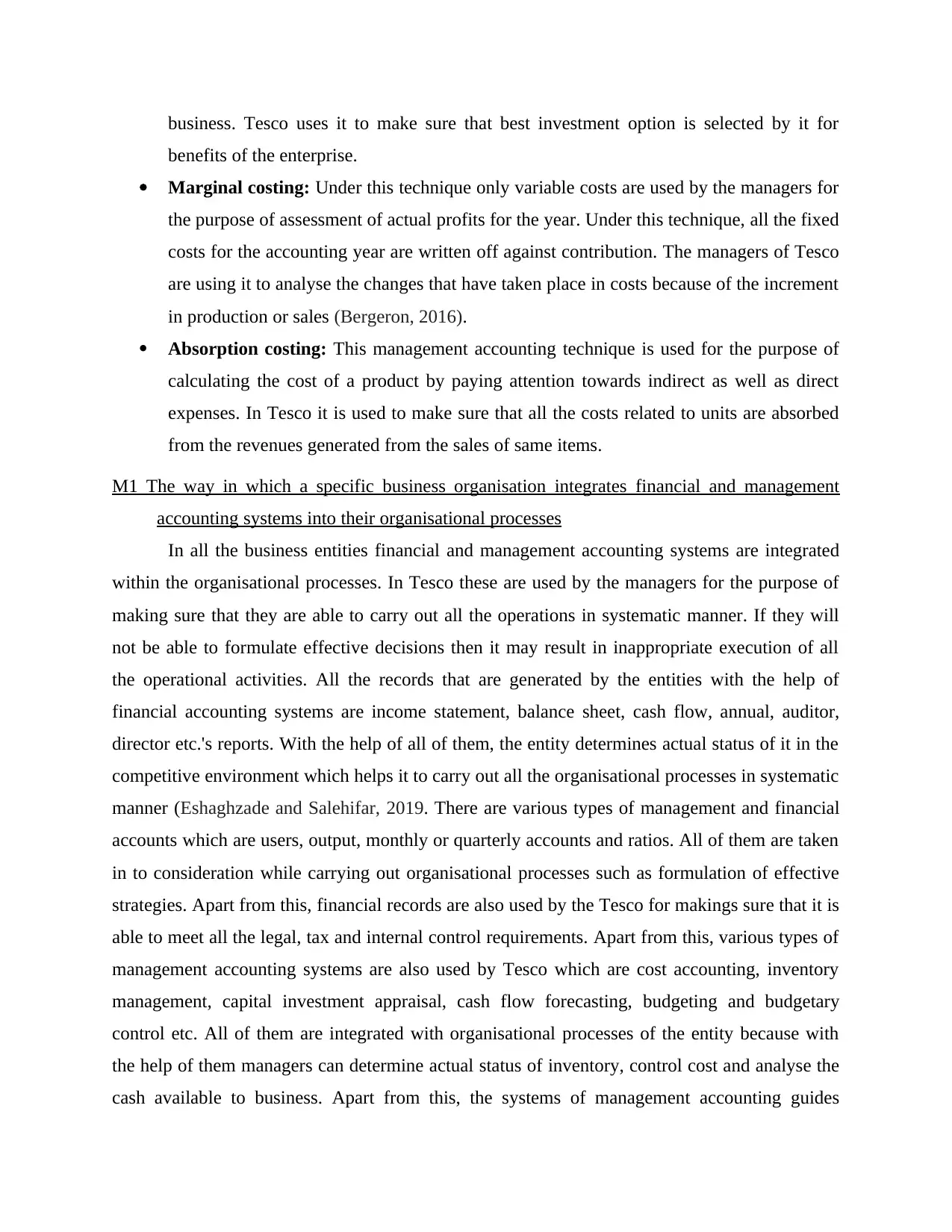
business. Tesco uses it to make sure that best investment option is selected by it for
benefits of the enterprise.
Marginal costing: Under this technique only variable costs are used by the managers for
the purpose of assessment of actual profits for the year. Under this technique, all the fixed
costs for the accounting year are written off against contribution. The managers of Tesco
are using it to analyse the changes that have taken place in costs because of the increment
in production or sales (Bergeron, 2016).
Absorption costing: This management accounting technique is used for the purpose of
calculating the cost of a product by paying attention towards indirect as well as direct
expenses. In Tesco it is used to make sure that all the costs related to units are absorbed
from the revenues generated from the sales of same items.
M1 The way in which a specific business organisation integrates financial and management
accounting systems into their organisational processes
In all the business entities financial and management accounting systems are integrated
within the organisational processes. In Tesco these are used by the managers for the purpose of
making sure that they are able to carry out all the operations in systematic manner. If they will
not be able to formulate effective decisions then it may result in inappropriate execution of all
the operational activities. All the records that are generated by the entities with the help of
financial accounting systems are income statement, balance sheet, cash flow, annual, auditor,
director etc.'s reports. With the help of all of them, the entity determines actual status of it in the
competitive environment which helps it to carry out all the organisational processes in systematic
manner (Eshaghzade and Salehifar, 2019. There are various types of management and financial
accounts which are users, output, monthly or quarterly accounts and ratios. All of them are taken
in to consideration while carrying out organisational processes such as formulation of effective
strategies. Apart from this, financial records are also used by the Tesco for makings sure that it is
able to meet all the legal, tax and internal control requirements. Apart from this, various types of
management accounting systems are also used by Tesco which are cost accounting, inventory
management, capital investment appraisal, cash flow forecasting, budgeting and budgetary
control etc. All of them are integrated with organisational processes of the entity because with
the help of them managers can determine actual status of inventory, control cost and analyse the
cash available to business. Apart from this, the systems of management accounting guides
benefits of the enterprise.
Marginal costing: Under this technique only variable costs are used by the managers for
the purpose of assessment of actual profits for the year. Under this technique, all the fixed
costs for the accounting year are written off against contribution. The managers of Tesco
are using it to analyse the changes that have taken place in costs because of the increment
in production or sales (Bergeron, 2016).
Absorption costing: This management accounting technique is used for the purpose of
calculating the cost of a product by paying attention towards indirect as well as direct
expenses. In Tesco it is used to make sure that all the costs related to units are absorbed
from the revenues generated from the sales of same items.
M1 The way in which a specific business organisation integrates financial and management
accounting systems into their organisational processes
In all the business entities financial and management accounting systems are integrated
within the organisational processes. In Tesco these are used by the managers for the purpose of
making sure that they are able to carry out all the operations in systematic manner. If they will
not be able to formulate effective decisions then it may result in inappropriate execution of all
the operational activities. All the records that are generated by the entities with the help of
financial accounting systems are income statement, balance sheet, cash flow, annual, auditor,
director etc.'s reports. With the help of all of them, the entity determines actual status of it in the
competitive environment which helps it to carry out all the organisational processes in systematic
manner (Eshaghzade and Salehifar, 2019. There are various types of management and financial
accounts which are users, output, monthly or quarterly accounts and ratios. All of them are taken
in to consideration while carrying out organisational processes such as formulation of effective
strategies. Apart from this, financial records are also used by the Tesco for makings sure that it is
able to meet all the legal, tax and internal control requirements. Apart from this, various types of
management accounting systems are also used by Tesco which are cost accounting, inventory
management, capital investment appraisal, cash flow forecasting, budgeting and budgetary
control etc. All of them are integrated with organisational processes of the entity because with
the help of them managers can determine actual status of inventory, control cost and analyse the
cash available to business. Apart from this, the systems of management accounting guides
Paraphrase This Document
Need a fresh take? Get an instant paraphrase of this document with our AI Paraphraser
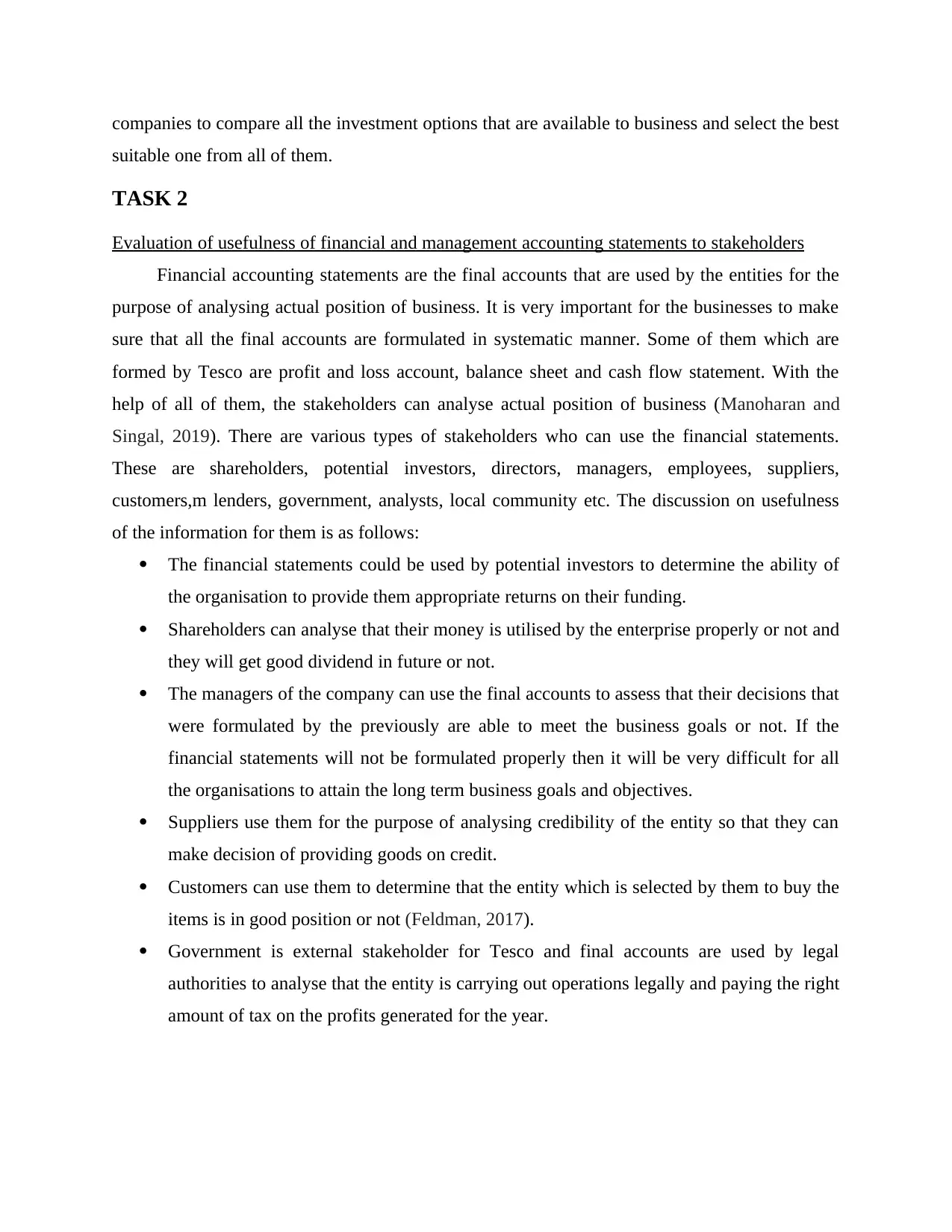
companies to compare all the investment options that are available to business and select the best
suitable one from all of them.
TASK 2
Evaluation of usefulness of financial and management accounting statements to stakeholders
Financial accounting statements are the final accounts that are used by the entities for the
purpose of analysing actual position of business. It is very important for the businesses to make
sure that all the final accounts are formulated in systematic manner. Some of them which are
formed by Tesco are profit and loss account, balance sheet and cash flow statement. With the
help of all of them, the stakeholders can analyse actual position of business (Manoharan and
Singal, 2019). There are various types of stakeholders who can use the financial statements.
These are shareholders, potential investors, directors, managers, employees, suppliers,
customers,m lenders, government, analysts, local community etc. The discussion on usefulness
of the information for them is as follows:
The financial statements could be used by potential investors to determine the ability of
the organisation to provide them appropriate returns on their funding.
Shareholders can analyse that their money is utilised by the enterprise properly or not and
they will get good dividend in future or not.
The managers of the company can use the final accounts to assess that their decisions that
were formulated by the previously are able to meet the business goals or not. If the
financial statements will not be formulated properly then it will be very difficult for all
the organisations to attain the long term business goals and objectives.
Suppliers use them for the purpose of analysing credibility of the entity so that they can
make decision of providing goods on credit.
Customers can use them to determine that the entity which is selected by them to buy the
items is in good position or not (Feldman, 2017).
Government is external stakeholder for Tesco and final accounts are used by legal
authorities to analyse that the entity is carrying out operations legally and paying the right
amount of tax on the profits generated for the year.
suitable one from all of them.
TASK 2
Evaluation of usefulness of financial and management accounting statements to stakeholders
Financial accounting statements are the final accounts that are used by the entities for the
purpose of analysing actual position of business. It is very important for the businesses to make
sure that all the final accounts are formulated in systematic manner. Some of them which are
formed by Tesco are profit and loss account, balance sheet and cash flow statement. With the
help of all of them, the stakeholders can analyse actual position of business (Manoharan and
Singal, 2019). There are various types of stakeholders who can use the financial statements.
These are shareholders, potential investors, directors, managers, employees, suppliers,
customers,m lenders, government, analysts, local community etc. The discussion on usefulness
of the information for them is as follows:
The financial statements could be used by potential investors to determine the ability of
the organisation to provide them appropriate returns on their funding.
Shareholders can analyse that their money is utilised by the enterprise properly or not and
they will get good dividend in future or not.
The managers of the company can use the final accounts to assess that their decisions that
were formulated by the previously are able to meet the business goals or not. If the
financial statements will not be formulated properly then it will be very difficult for all
the organisations to attain the long term business goals and objectives.
Suppliers use them for the purpose of analysing credibility of the entity so that they can
make decision of providing goods on credit.
Customers can use them to determine that the entity which is selected by them to buy the
items is in good position or not (Feldman, 2017).
Government is external stakeholder for Tesco and final accounts are used by legal
authorities to analyse that the entity is carrying out operations legally and paying the right
amount of tax on the profits generated for the year.
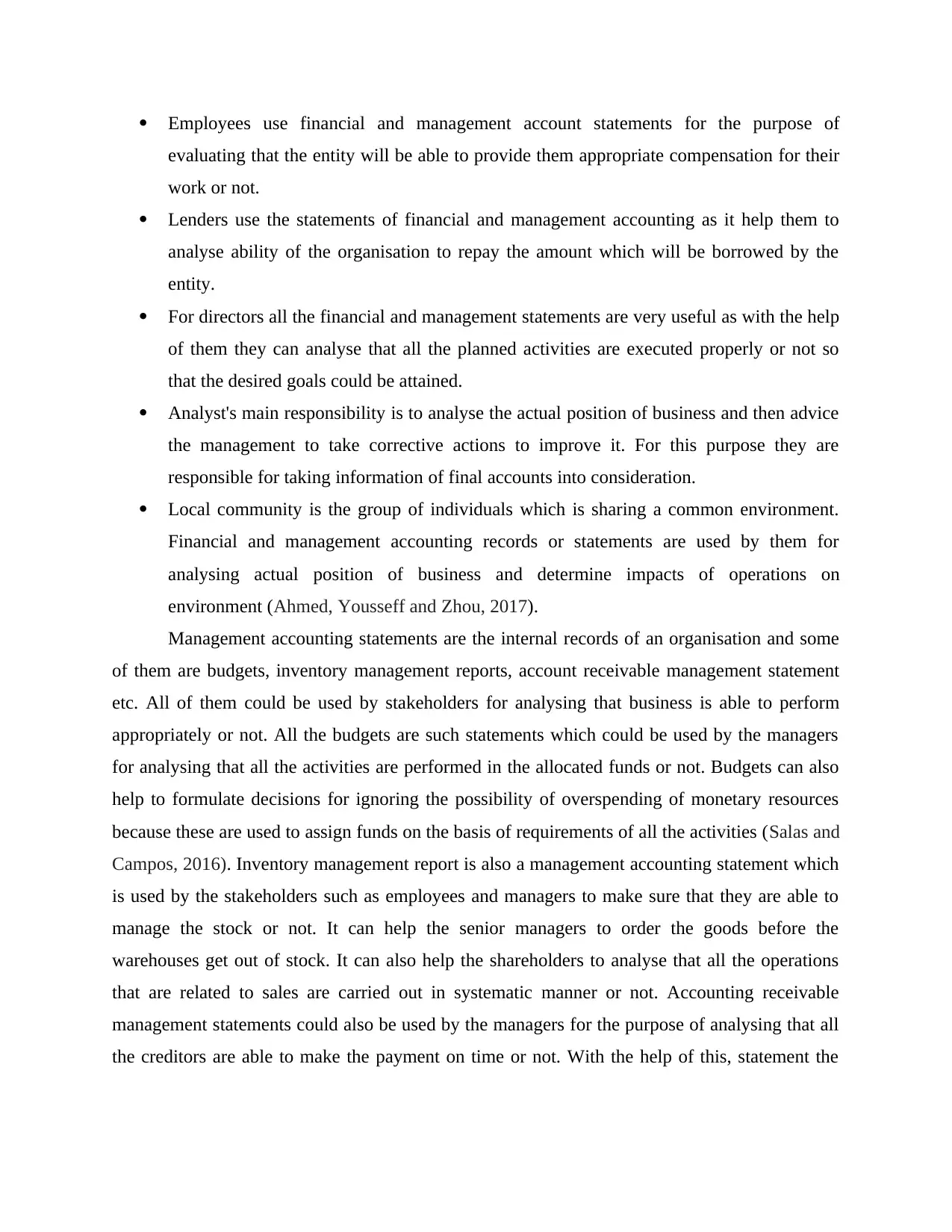
Employees use financial and management account statements for the purpose of
evaluating that the entity will be able to provide them appropriate compensation for their
work or not.
Lenders use the statements of financial and management accounting as it help them to
analyse ability of the organisation to repay the amount which will be borrowed by the
entity.
For directors all the financial and management statements are very useful as with the help
of them they can analyse that all the planned activities are executed properly or not so
that the desired goals could be attained.
Analyst's main responsibility is to analyse the actual position of business and then advice
the management to take corrective actions to improve it. For this purpose they are
responsible for taking information of final accounts into consideration.
Local community is the group of individuals which is sharing a common environment.
Financial and management accounting records or statements are used by them for
analysing actual position of business and determine impacts of operations on
environment (Ahmed, Yousseff and Zhou, 2017).
Management accounting statements are the internal records of an organisation and some
of them are budgets, inventory management reports, account receivable management statement
etc. All of them could be used by stakeholders for analysing that business is able to perform
appropriately or not. All the budgets are such statements which could be used by the managers
for analysing that all the activities are performed in the allocated funds or not. Budgets can also
help to formulate decisions for ignoring the possibility of overspending of monetary resources
because these are used to assign funds on the basis of requirements of all the activities (Salas and
Campos, 2016). Inventory management report is also a management accounting statement which
is used by the stakeholders such as employees and managers to make sure that they are able to
manage the stock or not. It can help the senior managers to order the goods before the
warehouses get out of stock. It can also help the shareholders to analyse that all the operations
that are related to sales are carried out in systematic manner or not. Accounting receivable
management statements could also be used by the managers for the purpose of analysing that all
the creditors are able to make the payment on time or not. With the help of this, statement the
evaluating that the entity will be able to provide them appropriate compensation for their
work or not.
Lenders use the statements of financial and management accounting as it help them to
analyse ability of the organisation to repay the amount which will be borrowed by the
entity.
For directors all the financial and management statements are very useful as with the help
of them they can analyse that all the planned activities are executed properly or not so
that the desired goals could be attained.
Analyst's main responsibility is to analyse the actual position of business and then advice
the management to take corrective actions to improve it. For this purpose they are
responsible for taking information of final accounts into consideration.
Local community is the group of individuals which is sharing a common environment.
Financial and management accounting records or statements are used by them for
analysing actual position of business and determine impacts of operations on
environment (Ahmed, Yousseff and Zhou, 2017).
Management accounting statements are the internal records of an organisation and some
of them are budgets, inventory management reports, account receivable management statement
etc. All of them could be used by stakeholders for analysing that business is able to perform
appropriately or not. All the budgets are such statements which could be used by the managers
for analysing that all the activities are performed in the allocated funds or not. Budgets can also
help to formulate decisions for ignoring the possibility of overspending of monetary resources
because these are used to assign funds on the basis of requirements of all the activities (Salas and
Campos, 2016). Inventory management report is also a management accounting statement which
is used by the stakeholders such as employees and managers to make sure that they are able to
manage the stock or not. It can help the senior managers to order the goods before the
warehouses get out of stock. It can also help the shareholders to analyse that all the operations
that are related to sales are carried out in systematic manner or not. Accounting receivable
management statements could also be used by the managers for the purpose of analysing that all
the creditors are able to make the payment on time or not. With the help of this, statement the
⊘ This is a preview!⊘
Do you want full access?
Subscribe today to unlock all pages.

Trusted by 1+ million students worldwide
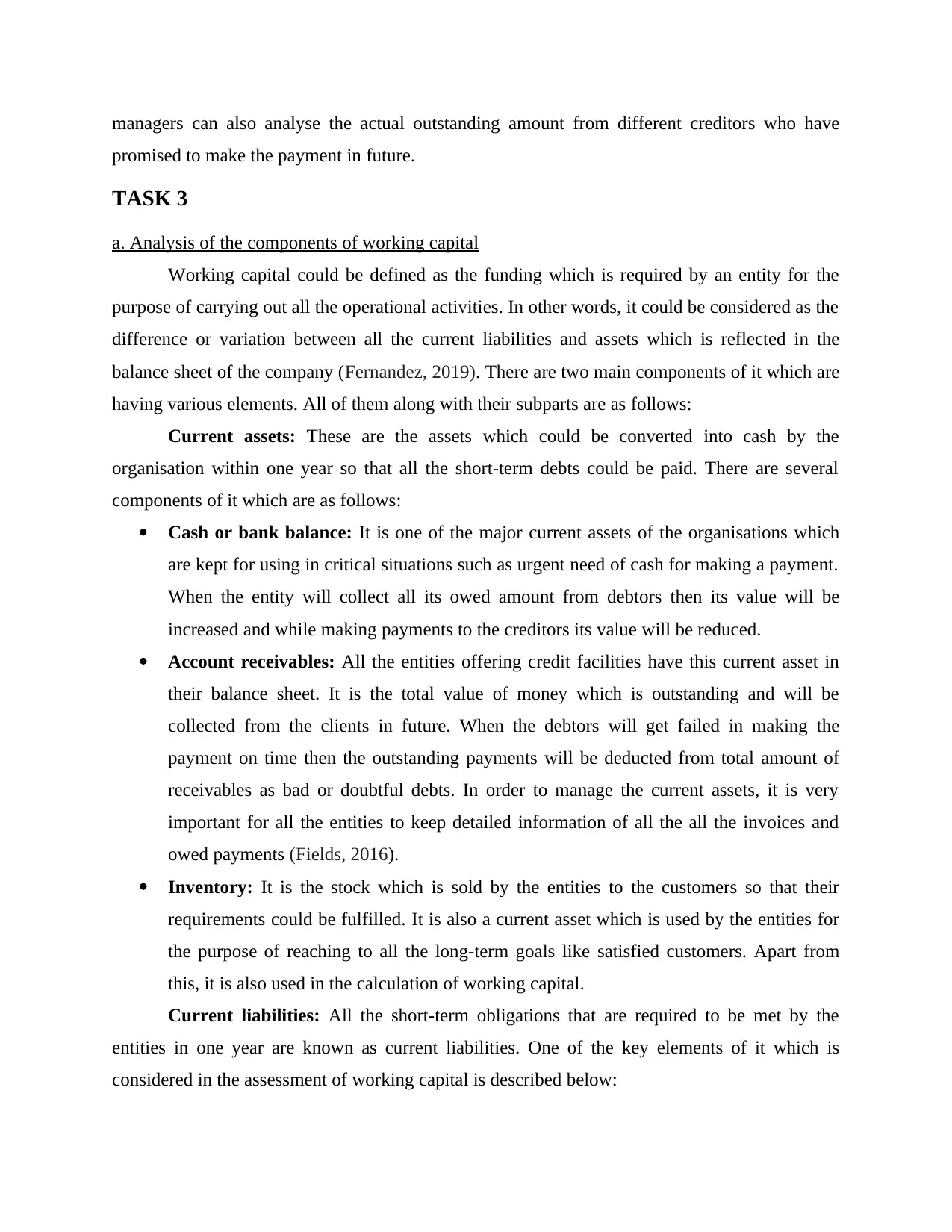
managers can also analyse the actual outstanding amount from different creditors who have
promised to make the payment in future.
TASK 3
a. Analysis of the components of working capital
Working capital could be defined as the funding which is required by an entity for the
purpose of carrying out all the operational activities. In other words, it could be considered as the
difference or variation between all the current liabilities and assets which is reflected in the
balance sheet of the company (Fernandez, 2019). There are two main components of it which are
having various elements. All of them along with their subparts are as follows:
Current assets: These are the assets which could be converted into cash by the
organisation within one year so that all the short-term debts could be paid. There are several
components of it which are as follows:
Cash or bank balance: It is one of the major current assets of the organisations which
are kept for using in critical situations such as urgent need of cash for making a payment.
When the entity will collect all its owed amount from debtors then its value will be
increased and while making payments to the creditors its value will be reduced.
Account receivables: All the entities offering credit facilities have this current asset in
their balance sheet. It is the total value of money which is outstanding and will be
collected from the clients in future. When the debtors will get failed in making the
payment on time then the outstanding payments will be deducted from total amount of
receivables as bad or doubtful debts. In order to manage the current assets, it is very
important for all the entities to keep detailed information of all the all the invoices and
owed payments (Fields, 2016).
Inventory: It is the stock which is sold by the entities to the customers so that their
requirements could be fulfilled. It is also a current asset which is used by the entities for
the purpose of reaching to all the long-term goals like satisfied customers. Apart from
this, it is also used in the calculation of working capital.
Current liabilities: All the short-term obligations that are required to be met by the
entities in one year are known as current liabilities. One of the key elements of it which is
considered in the assessment of working capital is described below:
promised to make the payment in future.
TASK 3
a. Analysis of the components of working capital
Working capital could be defined as the funding which is required by an entity for the
purpose of carrying out all the operational activities. In other words, it could be considered as the
difference or variation between all the current liabilities and assets which is reflected in the
balance sheet of the company (Fernandez, 2019). There are two main components of it which are
having various elements. All of them along with their subparts are as follows:
Current assets: These are the assets which could be converted into cash by the
organisation within one year so that all the short-term debts could be paid. There are several
components of it which are as follows:
Cash or bank balance: It is one of the major current assets of the organisations which
are kept for using in critical situations such as urgent need of cash for making a payment.
When the entity will collect all its owed amount from debtors then its value will be
increased and while making payments to the creditors its value will be reduced.
Account receivables: All the entities offering credit facilities have this current asset in
their balance sheet. It is the total value of money which is outstanding and will be
collected from the clients in future. When the debtors will get failed in making the
payment on time then the outstanding payments will be deducted from total amount of
receivables as bad or doubtful debts. In order to manage the current assets, it is very
important for all the entities to keep detailed information of all the all the invoices and
owed payments (Fields, 2016).
Inventory: It is the stock which is sold by the entities to the customers so that their
requirements could be fulfilled. It is also a current asset which is used by the entities for
the purpose of reaching to all the long-term goals like satisfied customers. Apart from
this, it is also used in the calculation of working capital.
Current liabilities: All the short-term obligations that are required to be met by the
entities in one year are known as current liabilities. One of the key elements of it which is
considered in the assessment of working capital is described below:
Paraphrase This Document
Need a fresh take? Get an instant paraphrase of this document with our AI Paraphraser
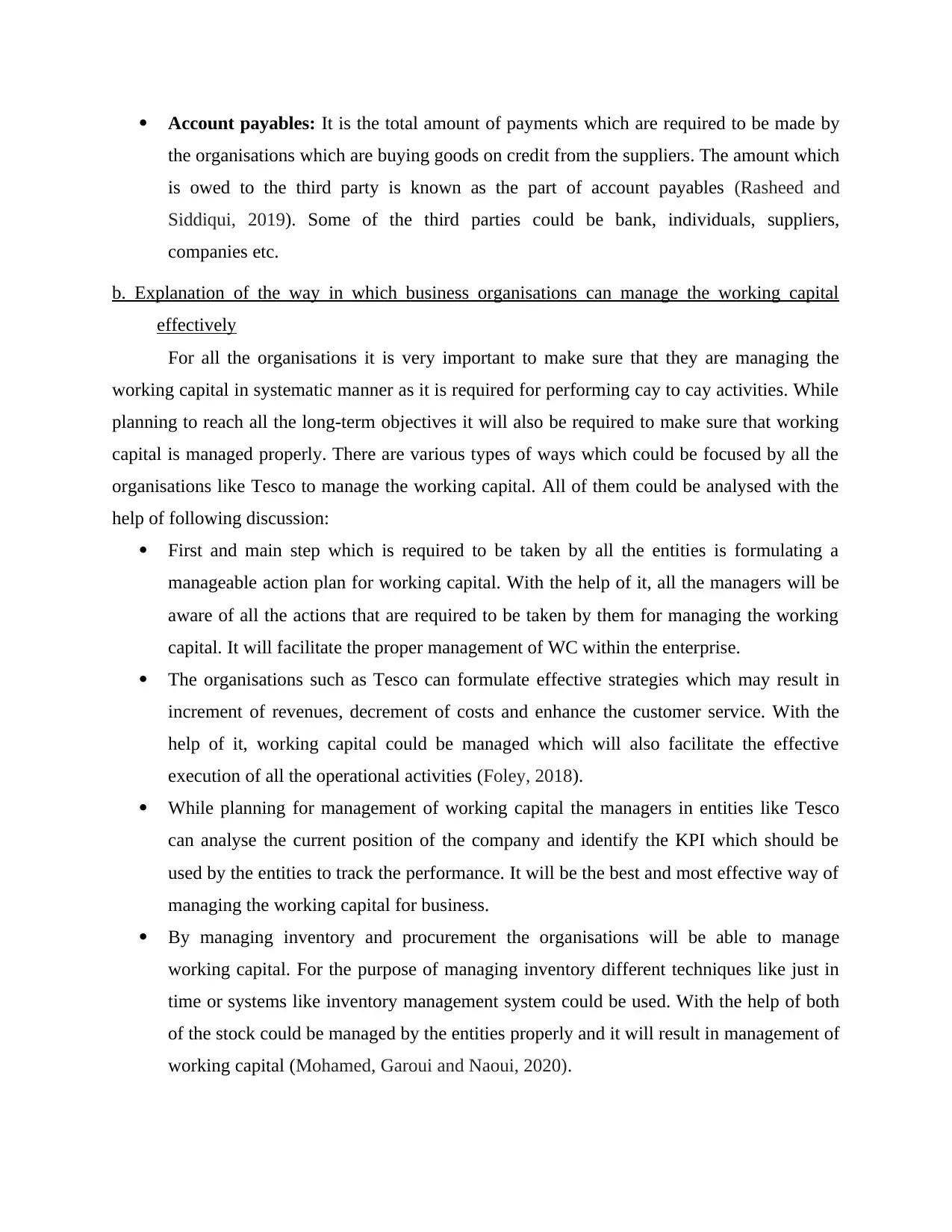
Account payables: It is the total amount of payments which are required to be made by
the organisations which are buying goods on credit from the suppliers. The amount which
is owed to the third party is known as the part of account payables (Rasheed and
Siddiqui, 2019). Some of the third parties could be bank, individuals, suppliers,
companies etc.
b. Explanation of the way in which business organisations can manage the working capital
effectively
For all the organisations it is very important to make sure that they are managing the
working capital in systematic manner as it is required for performing cay to cay activities. While
planning to reach all the long-term objectives it will also be required to make sure that working
capital is managed properly. There are various types of ways which could be focused by all the
organisations like Tesco to manage the working capital. All of them could be analysed with the
help of following discussion:
First and main step which is required to be taken by all the entities is formulating a
manageable action plan for working capital. With the help of it, all the managers will be
aware of all the actions that are required to be taken by them for managing the working
capital. It will facilitate the proper management of WC within the enterprise.
The organisations such as Tesco can formulate effective strategies which may result in
increment of revenues, decrement of costs and enhance the customer service. With the
help of it, working capital could be managed which will also facilitate the effective
execution of all the operational activities (Foley, 2018).
While planning for management of working capital the managers in entities like Tesco
can analyse the current position of the company and identify the KPI which should be
used by the entities to track the performance. It will be the best and most effective way of
managing the working capital for business.
By managing inventory and procurement the organisations will be able to manage
working capital. For the purpose of managing inventory different techniques like just in
time or systems like inventory management system could be used. With the help of both
of the stock could be managed by the entities properly and it will result in management of
working capital (Mohamed, Garoui and Naoui, 2020).
the organisations which are buying goods on credit from the suppliers. The amount which
is owed to the third party is known as the part of account payables (Rasheed and
Siddiqui, 2019). Some of the third parties could be bank, individuals, suppliers,
companies etc.
b. Explanation of the way in which business organisations can manage the working capital
effectively
For all the organisations it is very important to make sure that they are managing the
working capital in systematic manner as it is required for performing cay to cay activities. While
planning to reach all the long-term objectives it will also be required to make sure that working
capital is managed properly. There are various types of ways which could be focused by all the
organisations like Tesco to manage the working capital. All of them could be analysed with the
help of following discussion:
First and main step which is required to be taken by all the entities is formulating a
manageable action plan for working capital. With the help of it, all the managers will be
aware of all the actions that are required to be taken by them for managing the working
capital. It will facilitate the proper management of WC within the enterprise.
The organisations such as Tesco can formulate effective strategies which may result in
increment of revenues, decrement of costs and enhance the customer service. With the
help of it, working capital could be managed which will also facilitate the effective
execution of all the operational activities (Foley, 2018).
While planning for management of working capital the managers in entities like Tesco
can analyse the current position of the company and identify the KPI which should be
used by the entities to track the performance. It will be the best and most effective way of
managing the working capital for business.
By managing inventory and procurement the organisations will be able to manage
working capital. For the purpose of managing inventory different techniques like just in
time or systems like inventory management system could be used. With the help of both
of the stock could be managed by the entities properly and it will result in management of
working capital (Mohamed, Garoui and Naoui, 2020).
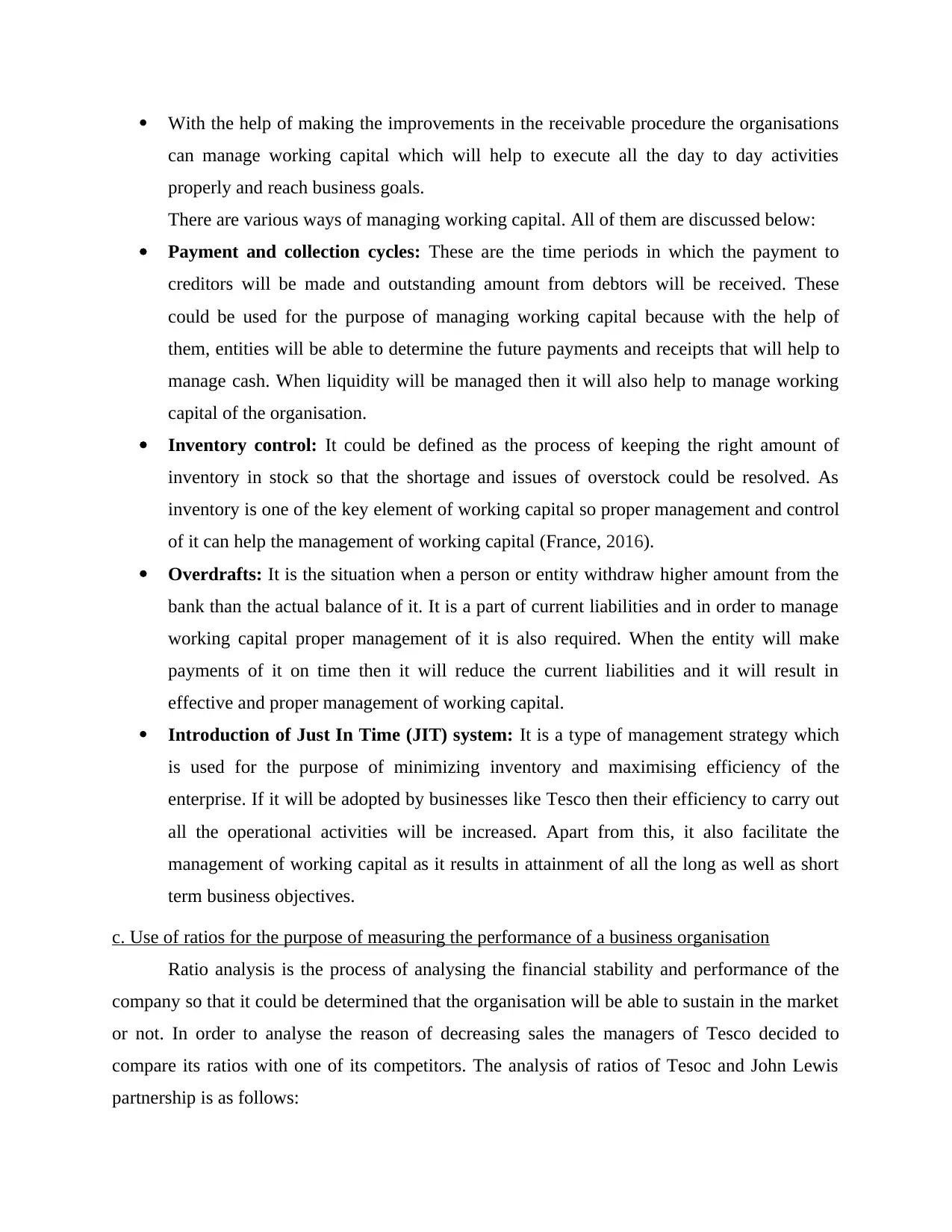
With the help of making the improvements in the receivable procedure the organisations
can manage working capital which will help to execute all the day to day activities
properly and reach business goals.
There are various ways of managing working capital. All of them are discussed below:
Payment and collection cycles: These are the time periods in which the payment to
creditors will be made and outstanding amount from debtors will be received. These
could be used for the purpose of managing working capital because with the help of
them, entities will be able to determine the future payments and receipts that will help to
manage cash. When liquidity will be managed then it will also help to manage working
capital of the organisation.
Inventory control: It could be defined as the process of keeping the right amount of
inventory in stock so that the shortage and issues of overstock could be resolved. As
inventory is one of the key element of working capital so proper management and control
of it can help the management of working capital (France, 2016).
Overdrafts: It is the situation when a person or entity withdraw higher amount from the
bank than the actual balance of it. It is a part of current liabilities and in order to manage
working capital proper management of it is also required. When the entity will make
payments of it on time then it will reduce the current liabilities and it will result in
effective and proper management of working capital.
Introduction of Just In Time (JIT) system: It is a type of management strategy which
is used for the purpose of minimizing inventory and maximising efficiency of the
enterprise. If it will be adopted by businesses like Tesco then their efficiency to carry out
all the operational activities will be increased. Apart from this, it also facilitate the
management of working capital as it results in attainment of all the long as well as short
term business objectives.
c. Use of ratios for the purpose of measuring the performance of a business organisation
Ratio analysis is the process of analysing the financial stability and performance of the
company so that it could be determined that the organisation will be able to sustain in the market
or not. In order to analyse the reason of decreasing sales the managers of Tesco decided to
compare its ratios with one of its competitors. The analysis of ratios of Tesoc and John Lewis
partnership is as follows:
can manage working capital which will help to execute all the day to day activities
properly and reach business goals.
There are various ways of managing working capital. All of them are discussed below:
Payment and collection cycles: These are the time periods in which the payment to
creditors will be made and outstanding amount from debtors will be received. These
could be used for the purpose of managing working capital because with the help of
them, entities will be able to determine the future payments and receipts that will help to
manage cash. When liquidity will be managed then it will also help to manage working
capital of the organisation.
Inventory control: It could be defined as the process of keeping the right amount of
inventory in stock so that the shortage and issues of overstock could be resolved. As
inventory is one of the key element of working capital so proper management and control
of it can help the management of working capital (France, 2016).
Overdrafts: It is the situation when a person or entity withdraw higher amount from the
bank than the actual balance of it. It is a part of current liabilities and in order to manage
working capital proper management of it is also required. When the entity will make
payments of it on time then it will reduce the current liabilities and it will result in
effective and proper management of working capital.
Introduction of Just In Time (JIT) system: It is a type of management strategy which
is used for the purpose of minimizing inventory and maximising efficiency of the
enterprise. If it will be adopted by businesses like Tesco then their efficiency to carry out
all the operational activities will be increased. Apart from this, it also facilitate the
management of working capital as it results in attainment of all the long as well as short
term business objectives.
c. Use of ratios for the purpose of measuring the performance of a business organisation
Ratio analysis is the process of analysing the financial stability and performance of the
company so that it could be determined that the organisation will be able to sustain in the market
or not. In order to analyse the reason of decreasing sales the managers of Tesco decided to
compare its ratios with one of its competitors. The analysis of ratios of Tesoc and John Lewis
partnership is as follows:
⊘ This is a preview!⊘
Do you want full access?
Subscribe today to unlock all pages.

Trusted by 1+ million students worldwide
1 out of 28
Related Documents
Your All-in-One AI-Powered Toolkit for Academic Success.
+13062052269
info@desklib.com
Available 24*7 on WhatsApp / Email
![[object Object]](/_next/static/media/star-bottom.7253800d.svg)
Unlock your academic potential
Copyright © 2020–2025 A2Z Services. All Rights Reserved. Developed and managed by ZUCOL.





